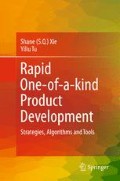Abstract
Process planning has become an important stage for OKP companies as global competition has intensified the need to reduce the cost of products. This chapter uses sheet metal work as an example to discuss how new algorithms can be used to improve efficiency and to reduce cost. An optimal process planner can maximise the utilisation of costly raw material resources, improve machining efficiency, and hence reduce product cost. However, two problems must be overcome before such an optimal process planner can be developed; nesting and machining path planning. The nesting requirement is to maximise sheet metal material utilisation ratio by nesting parts of various shapes into the sheet. The path planning requirement is to optimise machining sequence so that the total machining path distance and machining time are minimised. This work investigates the two problems using genetic algorithms. The proposed genetic algorithm approach uses a genetic encoding scheme and a genetic reproduction strategy to reach an optimum solution. Case studies are carried out to test the genetic algorithms. The effectiveness of the genetic algorithm path planning approach is compared with that of the “ant colony” algorithm (Wang and Xie 2005). The results show that the genetic algorithm achieves better performances for path planning than the ant colony algorithm.
Access this chapter
Tax calculation will be finalised at checkout
Purchases are for personal use only
References
Albano, A. and Sapuppo, G., 1980, Optimal location of two-dimensional irregular shapes using heuristic search methods, IEEE Transactions on Systems, Man, and Cybernetics, 10(5), 242–248.
Clark, S. C. and Carbone, V. T., 1980, Laser Cutting Head Attachment for Punch Press. United States Patent and Trademark Office, Houaille Industries, Inc., United States, Patent No. 4201905.
Dori, D. and Ben-Bassat, M., 1984, Efficient nesting of congruent convex figures. Communications of the ACM, 27, 228–235.
Han, G. C. and Na, S. J., 1996, Two-stage approach foresting in two-dimensional cutting problems using neural network and simulated annealing, Proceedings of Institution of Mechanical Engineers, Part:B Journal of Engineering Manufacture, 210, 509–519.
Hopper, E. and Turton, B., 1999, A genetic algorithm for A 2D industrial packing problem, Computers & Industrial Engineering 37, 375–378.
Hwang, Y. and Ahuja, N., 1992, Gross motion planning: a survey, ACM Computing Surveys, 24(3), 219–291.
Lesh, N. and Marks, J., 2000, Human guided simple search. A Mitsubishi Electric Research Laboratory, http://www.merl.com.
Meeran, S. and Shafie, A., 1997, Optimum path planning using convex hull and local search heuristic algorithms, Mechatronics, 7(8), 737–756.
Nee, Y. C., Seow, K. W. and Long, V. C., 1986, Designing algorithm for nesting irregular shapes with and without boundary constraints, Annals of CIRP, 35(1), 107–110.
Qu, W. and Sanders, J. L., 1987, A nesting algorithm for irregular parts and factors affecting trim losses, International Journal of Production Research, 25, 381–397.
Wang, G. G. and Xie, S. Q. 2005, Optimal process planning for a combined punch and laser cutting machine using ant colony optimisation, International Journal of Production Research, 43(11), 2195–2216.
Wang, Q., Teng, N., Cai, D. M., Zhang, S. H., 2010, Study on Deformation Mechanism of Tube Hydropiercing. Advanced Materials Research, Vols. 97–101, pp. 166–169.
Xie, S. Q. and Xu, X. 2006, A STEP-compliant integrated system for sheet metal parts, International Journal of Integrated Manufacturing Technology, 19(6), 627–638.
Xie, S. Q., Tu, Y. L., Liu, J. Q. and Zhou, Z. D., 2001, Integrated and concurrent approach for compound sheet metal cutting and punching. International Journal of Production Research, 39(6), 1095–1112.
Author information
Authors and Affiliations
Rights and permissions
Copyright information
© 2011 Springer
About this chapter
Cite this chapter
Xie, S., Tu, Y. (2011). Optimal Process Planning for Compound Laser Cutting and Punching Using Genetic Algorithms. In: Rapid One-of-a-kind Product Development. Springer, London. https://doi.org/10.1007/978-1-84996-341-1_15
Download citation
DOI: https://doi.org/10.1007/978-1-84996-341-1_15
Publisher Name: Springer, London
Print ISBN: 978-1-84996-340-4
Online ISBN: 978-1-84996-341-1
eBook Packages: EngineeringEngineering (R0)

